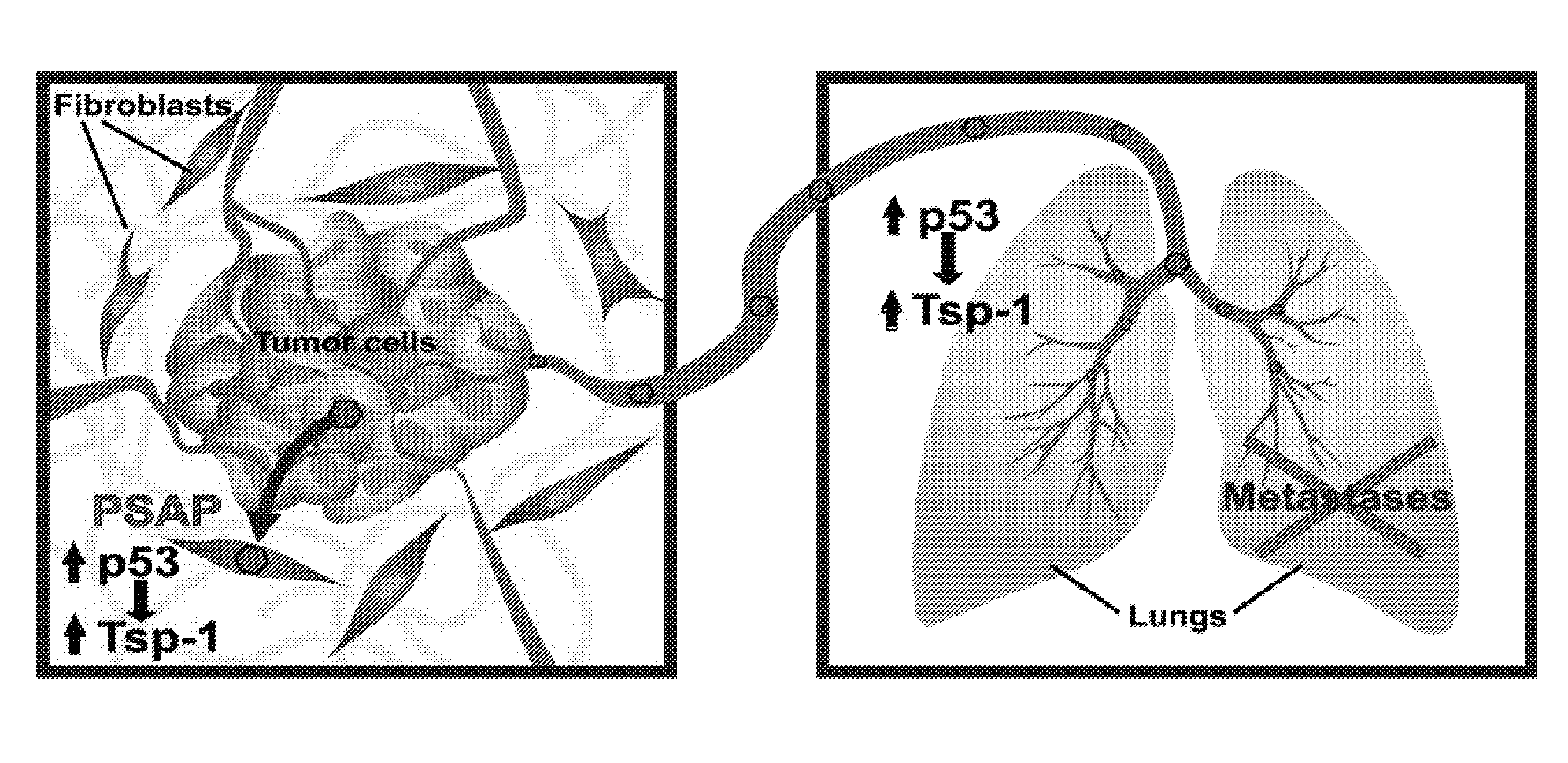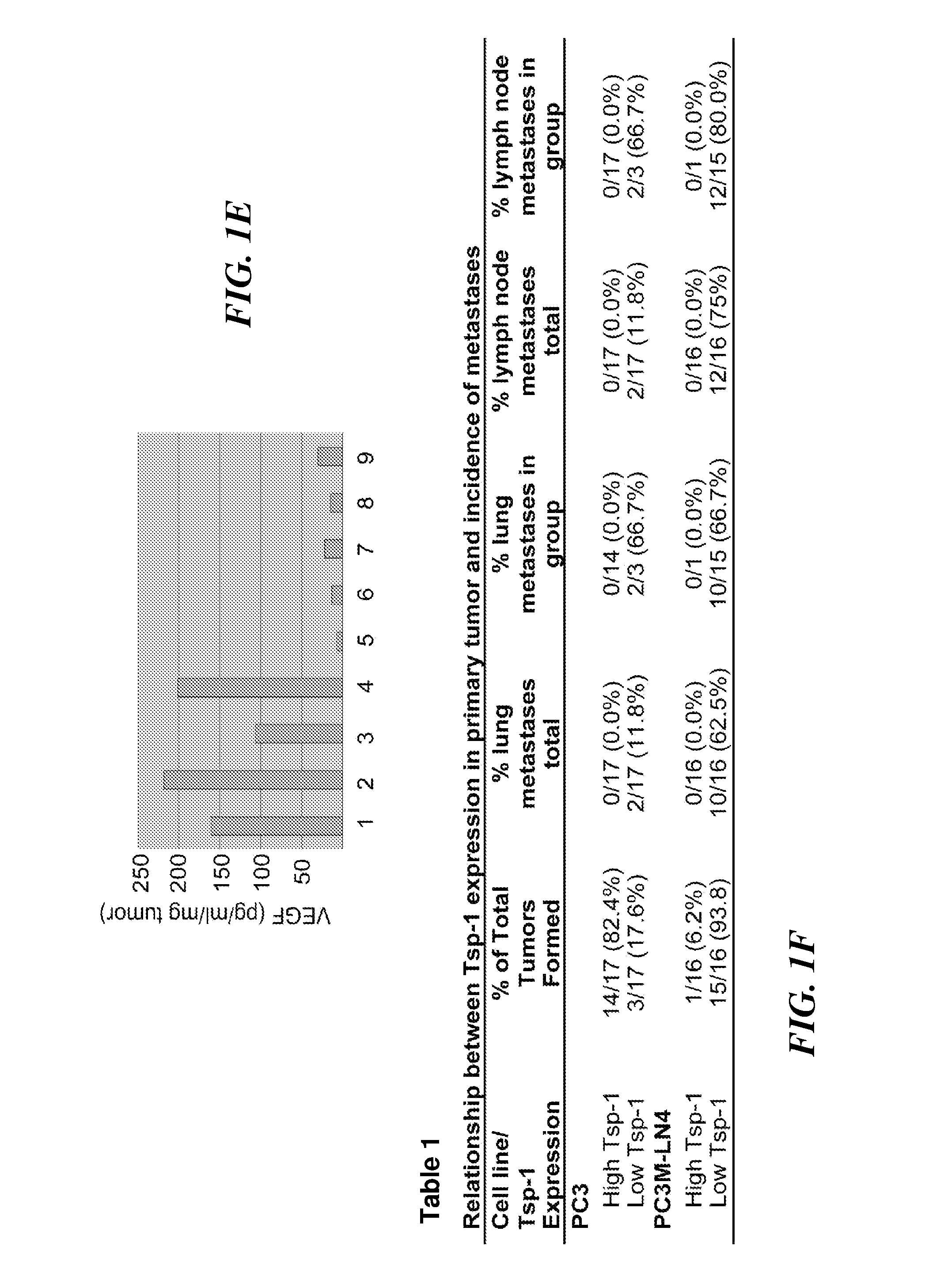Methods and uses thereof of prosaposin
a tumor and prosthesis technology, applied in the field of tumor metastasis treatment, can solve the problems of not meeting the requirements of tumor establishment and growth at the metastatic site, and the regulation of thrombospondin (tsp-1), one of the most potent endogenous anti-angiogenic proteins, in the tumor-associated stroma, etc., to facilitate recombinant protein expression and purification, and improve serum half-life in vivo.
- Summary
- Abstract
- Description
- Claims
- Application Information
AI Technical Summary
Benefits of technology
Problems solved by technology
Method used
Image
Examples
example 1
Tsp-1 Expression is Inversely Related to Metastatic Potential
[0383]The initial step of metastasis is dependent on access to the vasculature or lymphatic system. Metastatic human tumors may differ in the relative of expression of pro- and anti-angiogenic proteins compared to non-metastatic tumors. Thus, the level of VEGF secretion by the weakly metastatic prostate cancer cell line PC3 and a metastatic derivative PC3M-LN4 as well as by the breast cancer cell line MDA-MB-231 and a bone-specific metastatic derivative MDA-MET were measured. PC3M-LN4 cells have been documented to metastasize to multiple organs, including lymph node, liver, lung and bone, while MDA-MET was derived to metastasize only to bone via intra-cardiac injection (Bendre et al., 2002; Pettaway et al., 1996).
[0384]Highly metastatic PC3M-LN4 cells and MDA-MET cells secreted lower levels of VEGF than their parental counterparts, as measured by ELISA (FIG. 1A). Even under hypoxic conditions (1% O2), the relative levels r...
example 2
Myc Expression is Directly Related to Metastatic Potential
[0386]It has been demonstrated that c-myc is often amplified or overexpressed in several types of human cancer, including prostate and breast cancer (Escot et al., 1986; Nag and Smith, 1989). Furthermore, c-Myc represses the expression of Tsp-1 (Janz et al., 2000; Ngo et al., 2000; Tikhonenko et al., 1996; Watnick et al., 2003). Therefore, the levels of c-Myc was analyzed to determine whether the levels of c-Myc increase as tumors progress to the metastatic phenotype. The levels of c-Myc increase with the metastatic potential of both prostate and breast cancer cells were examined. Protein expression of c-Myc was significantly increased in the highly metastatic PC3M-LN4 and MDA-MET cells as compared to the parental PC3 and MDA-MB-231 cells (FIG. 1B). Furthermore, levels of phosphorylated c-Myc, which have been shown to be directly involved in Tsp-1 repression (Watnick et al., 2003), were also significantly increased in the met...
example 3
Expression of Tsp-1 in Primary Tumors
[0387]In order to determine whether levels of Tsp-1 observed in in vitro culture conditions were representative of their expression levels in vivo, 2×106 PC3 and their metastatic derivatives, PC3M-LN4 cells, were injected orthotopically into the prostate glands of SCID mice. Five weeks after injection the tumors and surrounding tissue were analyzed for Tsp-1 expression via western blot analysis and immunohistochemistry. The prostate tumors formed by both PC3 and PC3M-LN4 cells were histologically characterized by significant nuclear atypia and a diffuse infiltrating growth pattern, i.e. poorly differentiated, often surrounding benign prostate glands. Strong Tsp-1 staining was observed in fibrous stroma surrounding the invading tumor cells in 14 out of 17 PC3 tumors (FIG. 1F) but in only one out of 16 PC3M-LN4 prostate tumors (FIG. 1F). Conversely, undetectable Tsp-1 staining was observed in the fibrous stroma surrounding the remaining tumors (3 / 1...
PUM
| Property | Measurement | Unit |
|---|---|---|
| Fraction | aaaaa | aaaaa |
| Therapeutic | aaaaa | aaaaa |
Abstract
Description
Claims
Application Information
 Login to View More
Login to View More - R&D
- Intellectual Property
- Life Sciences
- Materials
- Tech Scout
- Unparalleled Data Quality
- Higher Quality Content
- 60% Fewer Hallucinations
Browse by: Latest US Patents, China's latest patents, Technical Efficacy Thesaurus, Application Domain, Technology Topic, Popular Technical Reports.
© 2025 PatSnap. All rights reserved.Legal|Privacy policy|Modern Slavery Act Transparency Statement|Sitemap|About US| Contact US: help@patsnap.com



